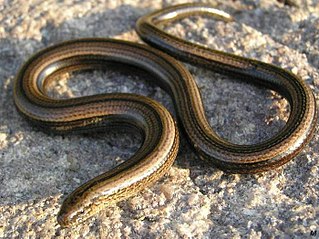
Pygopodidae, commonly known as legless lizards, snake-lizards, or flap-footed lizards, is a family of squamates with reduced or absent limbs, and are a type of gecko. At least 35 species are placed in two subfamilies and eight genera. They have unusually long, slender bodies, giving them a strong resemblance to snakes. Like snakes and most geckos, they have no eyelids, but unlike snakes, they have external ear holes and flat, unforked tongues. They are native to Australia and New Guinea.

Teiidae is a family of autarchoglossan lizards native to the Americas. Members of this family are generally known as whiptails or racerunners; however, tegus also belong to this family. Teiidae is sister to the Gymnopthalmidae, and both families comprise the Teiioidea. The Teiidae includes several parthenogenic species – a mode of clonal reproduction. Presently, the Teiidae consists of approximately 150 species in eighteen genera.

The Gerrhosauridae are a family of lizards native to Africa and Madagascar.

Anguidae refers to a large and diverse family of lizards native to the Northern Hemisphere. Common characteristics of this group include a reduced supratemporal arch, striations on the medial faces of tooth crowns, osteoderms, and a lateral fold in the skin of most taxa. The group includes the slowworms, glass lizards, and alligator lizards, among others. The family is divided into two subfamilies, and contains about 87 species in 8 genera.

Bachia is a genus of lizards that belong to the spectacled lizards family.

Gymnophthalmus is genus of lizards in the family Gymnophthalmidae. The genus is native to Mexico, Central America, and the northern part of South America. Eight species are recognized as being valid.

Night lizards are a group of small scincomorph lizards, averaging from less than 4 cm (1.6 in) to over 12 cm (4.7 in) snout–vent length. Most species are viviparous (live-bearing), with the exception of those in the genus Cricosaura. The family has only three living genera, with approximately 34 living species. The genera are divided by geographic range: Xantusia in southwestern North America and Baja California, Cricosaura in Cuba, and Lepidophyma, the most populous night lizard genus, in Central America. Three fossil genera are also known: Catactegenys, Palepidophyma, Palaeoxantusia.

The Amphisbaenidae are a family of amphisbaenians, a group of limbless vertebrates.

Trogonophidae is a small family of amphisbaenians, containing five species in four genera.

Legless lizard may refer to any of several groups of lizards that have independently lost limbs or reduced them to the point of being of no use in locomotion. It is the common name for the family Pygopodidae. These lizards are often distinguishable from snakes on the basis of one or more of the following characteristics: possessing eyelids, possessing external ear openings, lack of broad belly scales, notched rather than forked tongue, having two more-or-less-equal lungs, and/or having a very long tail.

Rhineura floridana, known commonly as the Florida worm lizard, graveyard snake, or thunderworm, is a species of amphisbaeninan in the family Rhineuridae. The species is the only extant member of the genus Rhineura, and is found primarily in Florida but has been recorded in Lanier County, Georgia. There are no subspecies that are recognized as being valid.

Potamites is a genus of lizards in the family Gymnophthalmidae. The genus is restricted to northern South America and southern Central America. They are semiaquatic and found near streams.

Loxopholis is a genus of lizards in the family Gymnophthalmidae. The genus is endemic to South America.
Alexandresaurus is a genus of lizard in the family Gymnophthalmidae. The genus is monotypic, i.e., it contains only one species, Alexandresaurus camacan. The species is endemic to Brazil.
Bachia pyburni is a species of lizard in the family Gymnophthalmidae. The species is endemic to South America.
Loxopholis guianense is a species of lizard in the family Gymnophthalmidae. It is found in Guyana, French Guiana, Suriname, and Brazil.
Loxopholis hexalepis, the six-scaled tegu, is a species of lizard in the family Gymnophthalmidae. It is found in Venezuela and Colombia.
Loxopholis ioanna is a species of lizard in the family Gymnophthalmidae. It is endemic to Colombia.
Loxopholis osvaldoi is a species of lizard in the family Gymnophthalmidae. The species is endemic to Brazil.












